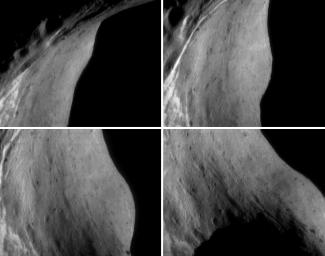
|
Tracking a Feature on Eros
- Click the image above for a larger view
- Full-Res JPEG (950 x 750) (63.9 kB)
- Full-Res TIFF (950 x 750) (467.5 kB)
Caption:
One of the strategies for characterizing the small-scale surface features on Eros is to photograph the same features under different lighting. Pictures taken with the Sun high in the sky show variations in the brightness of surface materials, while those taken when the Sun is low in the sky show morphology. Under a low Sun, the asteroid's rotation moves the direction of illumination, and linear features with different orientations are highlighted at different geometries.
A way to combine these measurements is in a "feature track," during which NEAR Shoemaker's camera is trained on a single site while the Sun moves through the sky. These four pictures were taken 18 minutes apart on October 7, 2000, during a feature track aimed at the inside of Eros' saddle region. The spacecraft was orbiting at an altitude of 103 kilometers (64 miles). Each frame is about 4.7 kilometers (2.9 miles) across. Variations in surface brightness are most conspicuous in the top two frames, whereas shallow grooves trending from the lower right to upper left are most easily seen in the bottom frames.
Background Info:
Built and managed by The Johns Hopkins University Applied Physics Laboratory, Laurel, Maryland, NEAR was the first spacecraft launched in NASA's Discovery Program of low-cost, small-scale planetary missions. See the NEAR web page at http://near.jhuapl.edu/ for more details.
Cataloging Keywords:
| Name | Value | Additional Values |
|---|---|---|
| Target | 433 Eros | |
| System | Near Earth Objects | |
| Target Type | Asteroid | |
| Mission | NEAR Shoemaker | |
| Instrument Host | NEAR Shoemaker | |
| Host Type | Orbiter | |
| Instrument | Multi-Spectral Imager (MSI) | |
| Detector | ||
| Extra Keywords | Grayscale, Rotation | |
| Acquisition Date | ||
| Release Date | 2001-02-17 | |
| Date in Caption | 2000-10-07 | |
| Image Credit | NASA/JPL/JHUAPL | |
| Source | photojournal.jpl.nasa.gov/catalog/PIA03115 | |
| Identifier | PIA03115 | |
